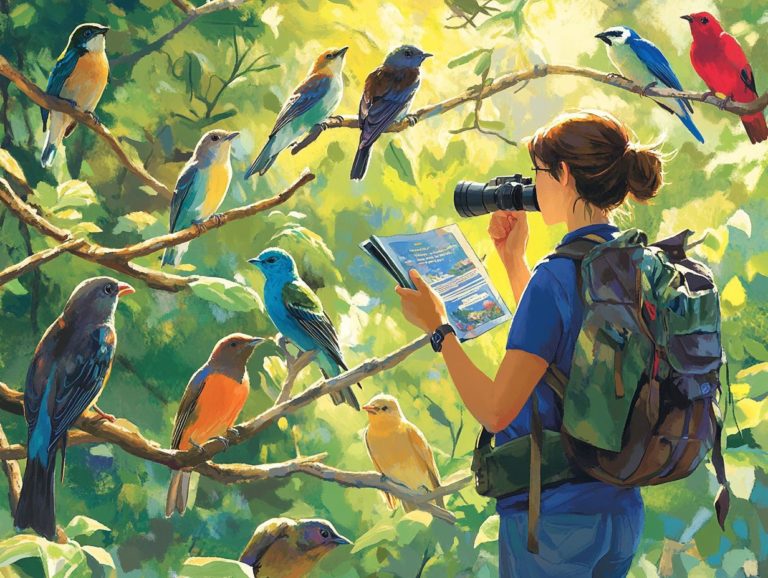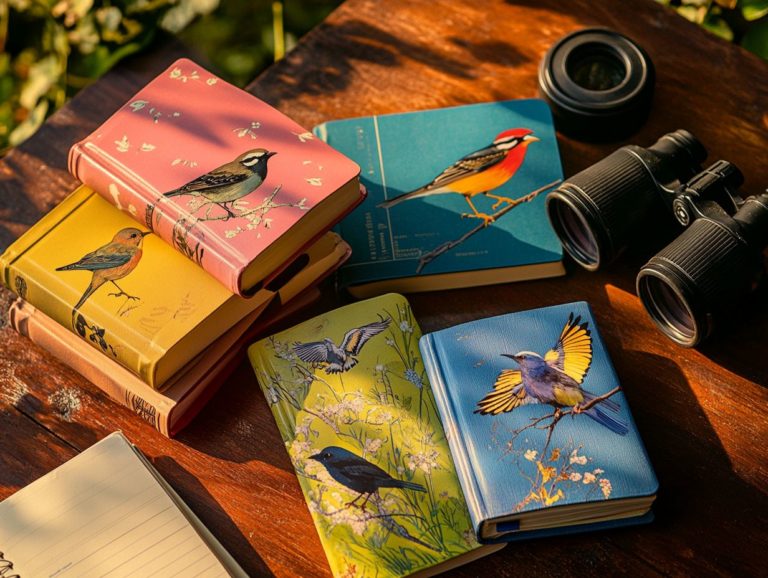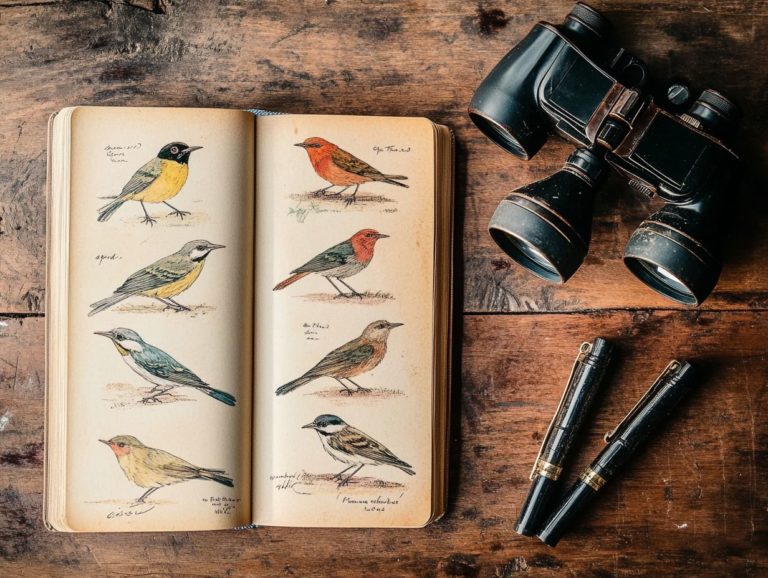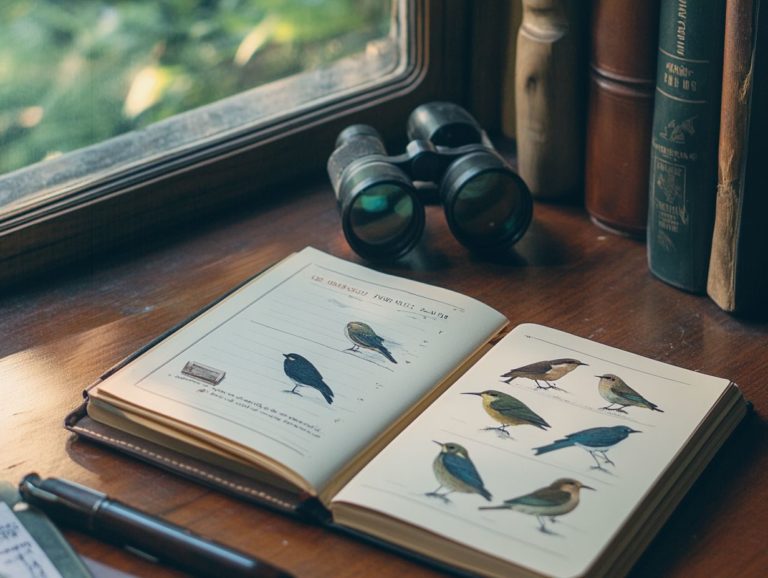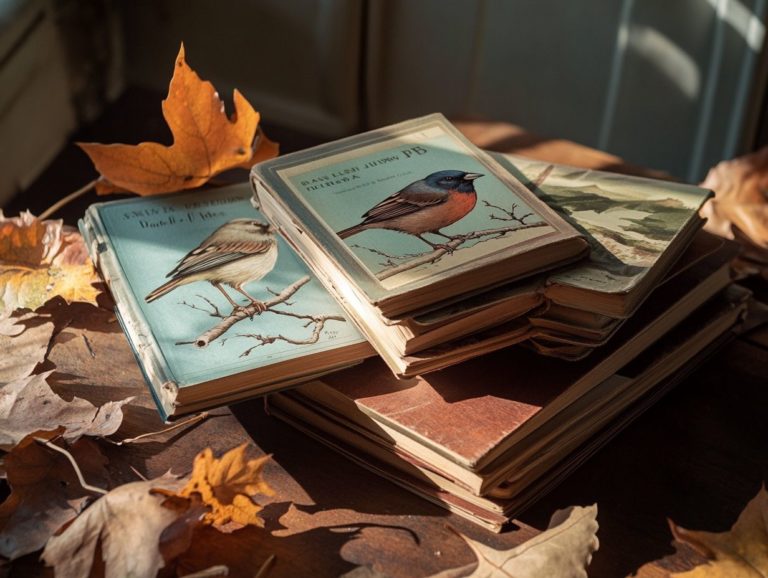Field Guides for Bird Watching in Urban Areas
Urban bird watching presents a remarkable opportunity for you to immerse yourself in the wonders of nature while navigating the vibrant pulse of city life. It s a chance to connect with wildlife in the most unexpected corners of your urban environment.
Whether you consider yourself a seasoned birder or are simply curious about this fascinating hobby, this guide will delve into the myriad aspects of observing birds in urban landscapes. You ll discover the many benefits of this rewarding pursuit, along with essential gear and expert tips for spotting our feathered companions.
Explore common species and ideal locations, and learn how to engage your family in this delightful pastime. Together, you can uncover the beauty and excitement that urban bird watching has to offer!
Contents
- Key Takeaways:
- 2. Benefits of Bird Watching in Urban Areas
- 3. Preparing for Urban Bird Watching
- 4. Essential Gear for Urban Bird Watching
- 5. Tips for Spotting Birds in Urban Areas
- 6. Common Urban Bird Species to Look Out For
- 7. How to Identify Birds in Urban Areas
- 8. Best Urban Bird Watching Locations
- 9. Etiquette for Urban Bird Watching
- 10. Challenges of Urban Bird Watching
- 11. How to Get Involved in Urban Bird Conservation
- 12. Urban Bird Watching for Families and Kids
- 13. Photography Tips for Urban Bird Watching
- 14. Resources for Urban Bird Watchers
- Frequently Asked Questions
- What are field guides for birdwatching in urban areas?
- What are field guides for bird watching in urban areas?
- Why are field guides important for bird watching in urban areas?
- Are there different types of field guides for bird watching in urban areas?
- Where can I find field guides for bird watching in urban areas?
- How do I use a field guide for bird watching in urban areas?
- Can I contribute information to field guides for bird watching in urban areas?
Key Takeaways:
- Bird watching in urban areas offers a unique and convenient way to connect with nature and enjoy the beauty of birds in your own city.
- Proper preparation and essential gear are key for successful urban bird watching, including binoculars, field guides, and appropriate clothing.
- Participating in urban bird conservation efforts is a meaningful way to contribute to the preservation of urban bird species and their habitats.
2. Benefits of Bird Watching in Urban Areas
Urban bird watching offers amazing benefits, from connecting with nature to making new friends! It also enhances community engagement through local bird watching groups and sheds light on the conservation challenges faced by urban bird species.
By observing birds in their natural urban habitats, you can experience profound stress relief, providing a much-needed mental escape from the relentless pace of city life. These activities motivate local governments and organizations to cultivate greener spaces, which ultimately improve ecological conditions for native wildlife.
As you connect with fellow enthusiasts, community ties flourish. Neighbors unite over their shared passion for birding. These gatherings facilitate knowledge exchange and elevate awareness of critical conservation efforts, encouraging urban residents like you to advocate for the preservation of both feathered friends and their habitats.
3. Preparing for Urban Bird Watching
Dive into your local area and find resources on bird identification. This will enhance your birding adventures!
Begin your engagement with the surroundings by researching nearby birding patches. This will lead you to hotspots where various species gather, significantly enhancing your chances of spotting a diverse array of birds.
Gather identification resources like field guides or birding apps to help you recognize different species and appreciate their unique characteristics. Understanding the impact of seasonal changes is also crucial as these shifts influence bird behavior, migration patterns, and visibility.
4. Essential Gear for Urban Bird Watching
Equipping yourself with the right gear for urban bird watching is essential. Use high-quality field guides and colorful photography manuals filled with vibrant images; these references will elevate your birding experience.
A good pair of binoculars is non-negotiable; they allow you to spot distant birds without causing any disturbance. Investing in lightweight and compact photography equipment is wise, as it enables you to capture stunning images of local species without the burden of heavy gear.
Keep a notebook handy for jotting down observations; this will sharpen your identification skills over time. Additionally, utilizing mobile apps that help recognize various bird calls and provide real-time updates on local sightings can significantly enrich your bird watching adventure, transforming urban environments into enchanting wildlife havens.
5. Tips for Spotting Birds in Urban Areas
Spotting birds in urban areas calls for a strategic approach and savvy birdwatching tips that boost your ability to identify local species. Utilizing field guides essential for every birdwatcher can also help foster community engagement within birdwatching groups.
Start by pinpointing prime locations where birds are often seen think parks, gardens, and waterfronts. Early mornings and late afternoons are your golden hours! That’s when birds are typically up and about, making your observations rewarding.
Pay attention to their behaviors, like feeding or nesting habits; these can provide valuable insights into their species and preferences.
Don t underestimate the power of tools! Field guides and bird identification apps can be game-changers, helping you quickly distinguish between similar-looking birds.
Join local birdwatching events! Don t miss the chance to connect with fellow bird lovers, as this allows for knowledge sharing and sharpens your skills through practice and collaboration.
6. Common Urban Bird Species to Look Out For
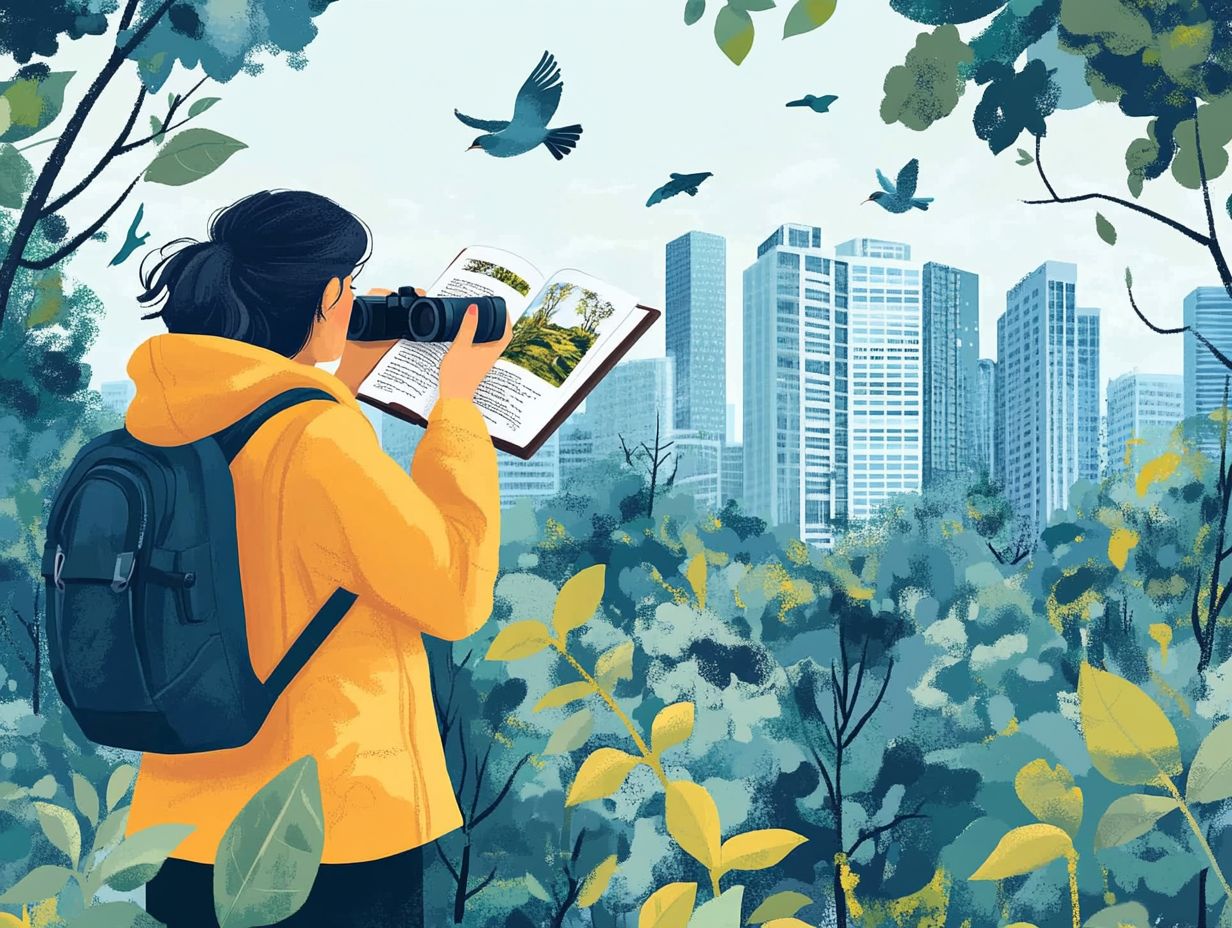
Understanding common urban bird species is essential for elevating your birdwatching experience. In the city, you’ll find many species that adapt to urban environments, showcasing impressive biodiversity that persists despite the challenges of climate change.
You might be greeted by familiar friends like the American robin, with its striking orange breast and delightful song, often foraging for worms on lush lawns. Don t underestimate the pigeons; often dismissed, they possess remarkable homing abilities and come in a stunning variety of hues, perfectly tailored to thrive in bustling structures.
Then there are the sparrows, lively and chirpy, frequently seen flocking in parks and eagerly snatching up crumbs from unsuspecting passersby.
These resilient species flourish in urban habitats thanks to abundant resources, like food from outdoor cafes and nesting spots in man-made structures. By observing their behaviors and interactions, you ll gain valuable insights into the workings of urban ecosystems and the unique challenges these birds face in their daily lives.
7. How to Identify Birds in Urban Areas
Identifying birds in urban areas requires mastering bird identification techniques methods used to recognize different bird species based on their features. Utilize range maps and groups of birds to develop ecological insights that make recognizing species more intuitive.
This journey begins with keen observation of key features like plumage color, size, shape, and unique markings that help set one species apart from another. Range maps become critical tools, illustrating where these birds are typically found, guiding you in recognizing which species you re likely to encounter in specific locales.
Grasping the relationship between various ecological factors such as habitat preferences and seasonal behaviors can significantly enhance your ability to identify birds with confidence. By blending these methods, you can cultivate a deeper appreciation for the rich avian diversity flourishing in your urban surroundings.
8. Best Urban Bird Watching Locations
The finest urban birdwatching locations invite you to immerse yourself in the lively pulse of city life! Birding hotspots like New York City and San Francisco stand out as exceptional venues for observing a rich variety of species while connecting with local birdwatching communities. For those just starting out, field guides serve as a valuable companion to enhance your experience.
In these bustling cities, parks and green spaces transform into essential habitats amid concrete surroundings. Take Central Park, for example it s famous for its remarkable diversity, showcasing species such as warblers and sparrows during migration seasons. Over in San Francisco, Golden Gate Park dazzles with lush gardens where you might catch a glimpse of vibrant hummingbirds and playful jays.
Local birdwatching groups enhance your experience! They organize guided tours, share fascinating insights about avian behavior, and host events that cultivate a sense of community among fellow enthusiasts. This not only enriches your understanding but also deepens your appreciation for the urban wildlife thriving around you.
9. Etiquette for Urban Bird Watching
Practicing proper etiquette during urban bird watching is key to respecting nature. It fosters community engagement and addresses conservation challenges.
Your actions directly impact both the birds’ well-being and the ecosystem. Avoid disturbances like loud noises or sudden movements for a peaceful observation experience.
Keep a respectful distance from nests and breeding areas. Use designated pathways to help preserve natural habitats.
Sharing experiences and tips builds camaraderie among bird watchers. This enhances enjoyment and highlights the importance of conservation awareness in urban settings.
10. Challenges of Urban Bird Watching
Urban bird watching can be fascinating yet challenging. It reveals the ecological impacts of urbanization and the conservation struggles of various bird species.
As cities expand, natural habitats shrink. This leads to a decline in biodiversity, which directly affects the number of bird species in urban areas.
Enhancing habitats through initiatives like green roofs, community gardens, and native landscaping is essential. Promoting wildflowers of North America can also support local birds.
Understanding local bird populations and their needs allows you to help protect them. You can provide critical resources like food and nesting sites.
Engaging in conservation efforts raises awareness about the importance of urban ecosystems and habitat enhancement. This fosters a harmonious relationship between people and nature.
11. How to Get Involved in Urban Bird Conservation
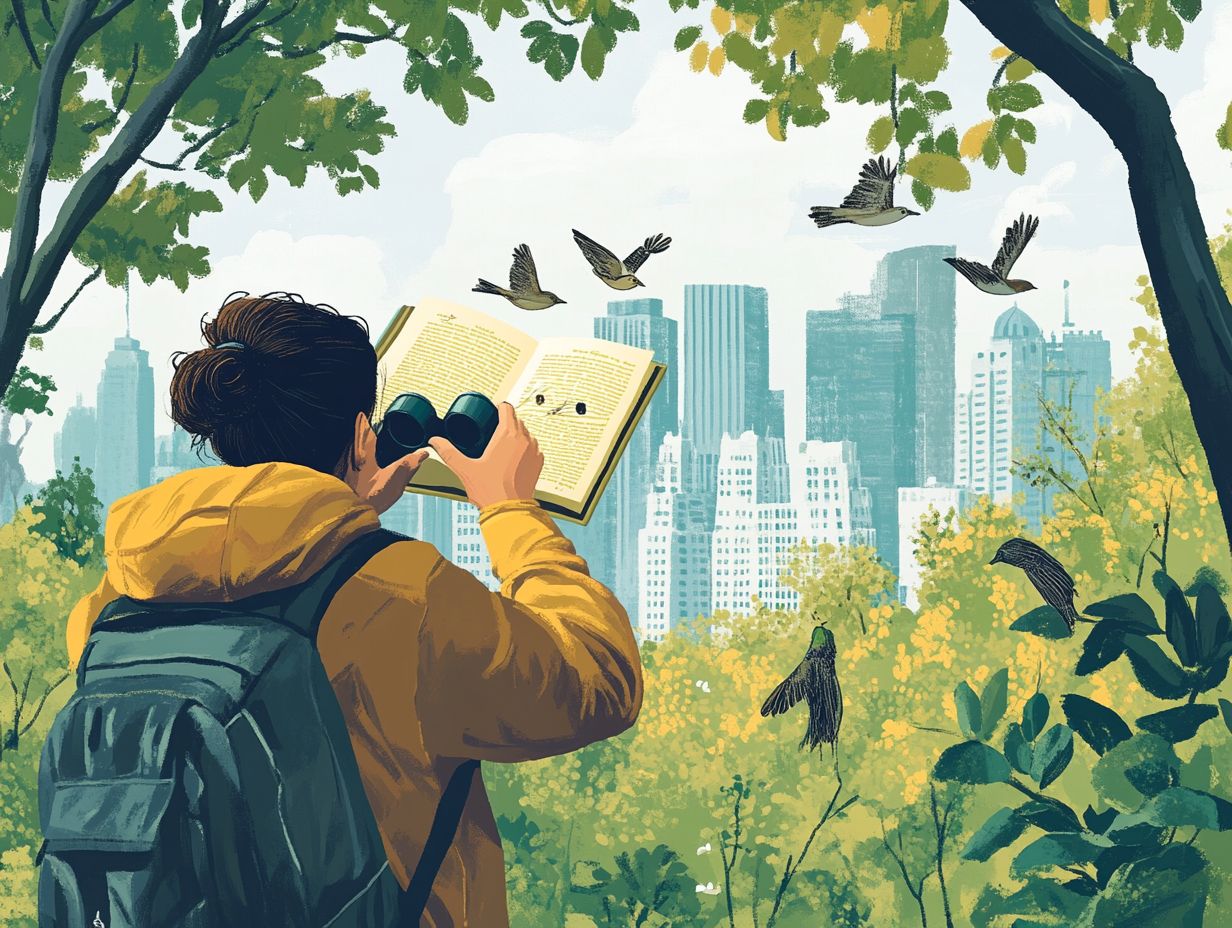
Getting involved in urban bird conservation is crucial for addressing the challenges that bird species face today. Organizations like the National Audubon Society and Audubon Texas provide opportunities to engage with your community and take part in meaningful conservation efforts.
By joining local birdwatching groups, you ll love discovering more about bird species. You ll also build connections with fellow enthusiasts who share your passion for urban birdwatching.
Volunteering for habitat restoration projects benefits the environment and gives you hands-on experience in maintaining vital ecosystems. Participating in events organized by these groups helps you understand local bird populations and how to protect them.
These activities allow you to enhance the health and diversity of urban wildlife. You ll ensure that future generations can enjoy the beauty of birds in their natural habitats!
12. Urban Bird Watching for Families and Kids
Urban bird watching is a fantastic way for your family to engage in activities that both novice birders and nature lovers will enjoy. Imagine turning outdoor trips into memorable birding adventures that ignite a passion for wildlife observation in your children!
As you stroll through local parks, try embarking on scavenger hunts to spot specific bird species. This activity not only encourages teamwork but also sharpens observation skills.
Engaging in hands-on activities, like building bird feeders or identifying local nests, sparks curiosity and wonder. You can even introduce your kids to the colorful wildflowers of North America.
Incorporate birding games like bingo or keep observation journals to inspire your kids. Participating in community events, such as guided bird walks, fosters friendships among young naturalists and promotes a sense of responsibility towards nature.
These exciting experiences make urban bird watching a delightful adventure for your entire family, allowing you all to explore the amazing variety of birds in your local environment!
13. Photography Tips for Urban Bird Watching
Capturing stunning images of urban birds takes finesse and the right photography techniques. This elevates your birding adventures into a realm of breathtaking full-color photographs that can be showcased alongside your favorite nature field guides.
To significantly boost your chances of nailing that perfect shot, consider investing in a quality telephoto lens. A quality telephoto lens is a camera lens that allows you to zoom in on distant subjects without causing any disturbances. It s equally important to fine-tune your camera settings. Opt for a fast shutter speed to freeze those dynamic moments in flight; this helps capture quick movements without blurriness. Ensure your aperture is wide enough to blur any distracting background elements, enhancing the overall quality of your photography guides.
Take the time to observe the behavior and routines of urban birds. This will inform your choice of locations and timing, enhancing both your experience and the quality of your images. Thoughtfully framing your shots, perhaps by incorporating intriguing architectural elements or natural surroundings, can provide unique perspectives. This enriches the story you re aiming to tell and connects your captures to the local birdwatching community.
14. Resources for Urban Bird Watchers
As an urban bird watcher, you have access to a wealth of invaluable resources that can elevate your birding experience. One such resource is field guides: tips for new bird watchers, which enhance your journey, from online databases that detail various bird species to handy identification tips and community platforms that connect you with local birding hotspots.
- These resources make finding birds easier and more enjoyable.
- They streamline your search for species checklists.
- They provide interactive maps that guide you to the best local birding locations.
Mobile applications like Merlin Bird ID and eBird are game-changers. They help you identify birds on the fly and allow you to log your sightings, contributing to the larger world of citizen science while integrating with nature lovers and supporting projects related to the American Ornithological Society.
Websites such as All About Birds offer extensive articles that delve into the intricacies of various species, including mushrooms of North America and wildflowers of North America. Local organizations, like Audubon Society chapters, frequently host guided bird walks and events, deepening your connection to the avian world.
Together, these tools and communities turn urban spaces into vibrant habitats for bird watching, offering a comprehensive guide for navigating the world of birds for all levels of birdwatching tips. Start exploring your urban environment with these tools and share your findings with fellow birdwatchers!
Frequently Asked Questions
What are field guides for birdwatching in urban areas?
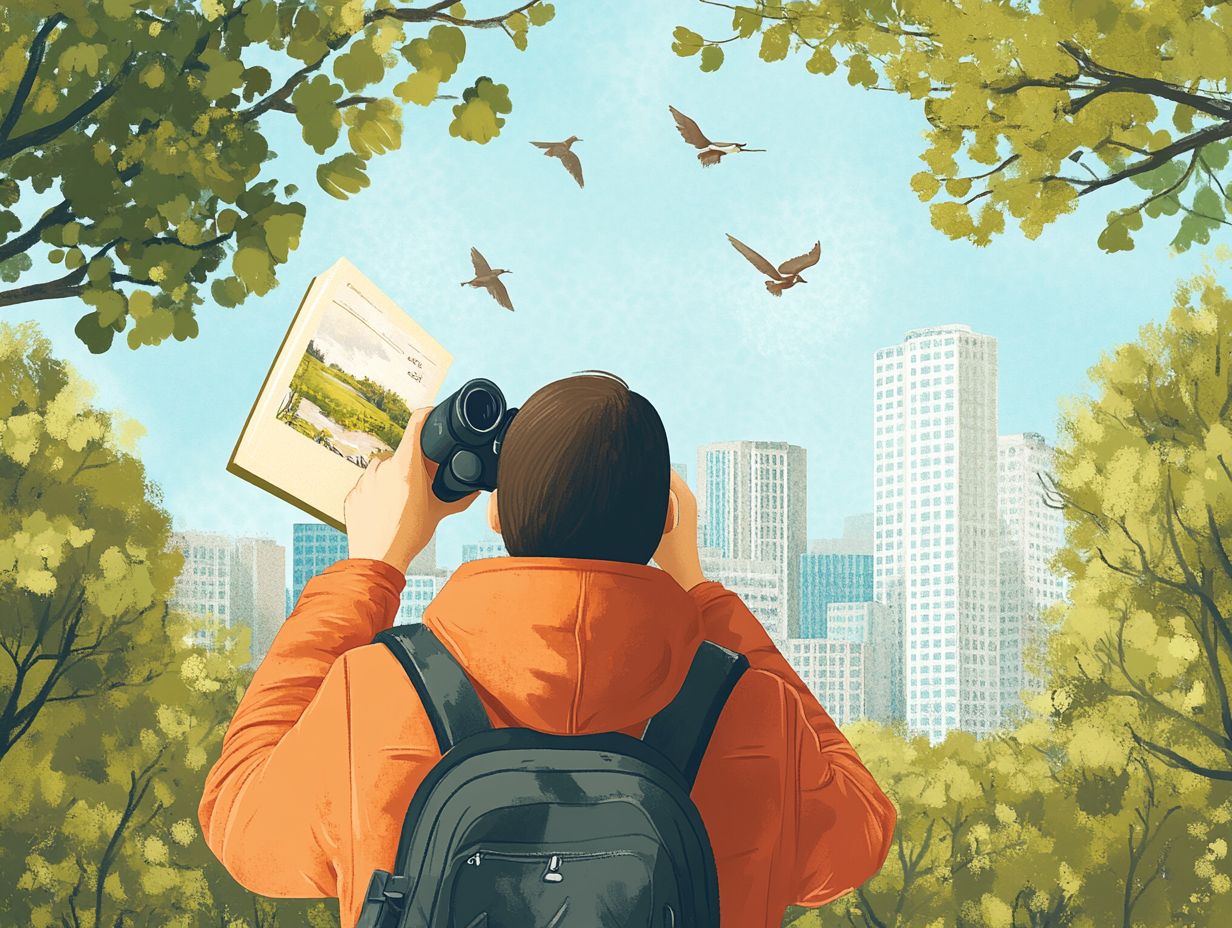
What are field guides for bird watching in urban areas?
Field guides for bird watching in urban areas are reference books that provide information about various bird species found in cities. They include illustrations and descriptions to help identify and learn about these birds, as well as identification tips for novice birders.
Why are field guides important for bird watching in urban areas?
Field guides are crucial for bird watchers in urban settings. They assist in identifying and learning about the different species of birds found in cities. Additionally, building your birdwatching knowledge provides insights into the behavior, habitat, and fascinating facts about these birds, including their scientific classifications.
Are there different types of field guides for bird watching in urban areas?
Yes, there are various types of field guides available. Some focus on specific regions or cities, while others cover a broader range of urban environments. Excitingly, there are field guides for beginners, as well as advanced guides for experienced bird watchers, including best-selling options widely recommended by enthusiasts.
Where can I find field guides for bird watching in urban areas?
You can find field guides at local bookstores, online retailers, or nearby nature centers and parks. Many bird watching clubs and organizations offer field guides for purchase or loan to their members, often including nature field guides that focus on local flora and fauna.
How do I use a field guide for bird watching in urban areas?
Start by familiarizing yourself with the field guide’s layout. Use it to identify birds by matching their physical traits with descriptions and maps.
Taking notes or using a checklist can help you track the birds you’ve spotted. This also contributes to understanding local wildlife.
Can I contribute information to field guides for bird watching in urban areas?
Yes! Many field guides welcome input from citizen scientists and amateur bird watchers.
If you have observations about local bird species, reach out to the publisher or author. They may include your insights in future editions, including important ecological changes.

